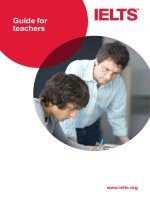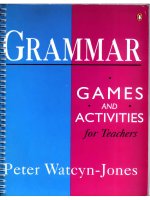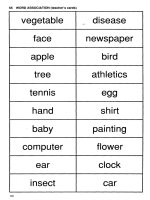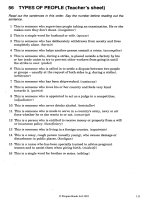yatcb notes for teachers
Bạn đang xem bản rút gọn của tài liệu. Xem và tải ngay bản đầy đủ của tài liệu tại đây (59.01 KB, 3 trang )
You Are The Course Book
Notes for Teachers
T stands for ‘teacher’ and SS for ‘student’ or ‘students’ throughout this book
In You Are The Course Book Method there are some conventions that occur repeatedly and appear
throughout the lesson plans in this book, for example:
General:
• This is topic-based learning – the topic gives a context to the language as it is used
• Activities can be adjusted to suit different levels – do more or less, with harder or easier
constructions and vocabulary
• Activities can be adjusted to fit different time slots – do more or less. T can edit the lesson plan as
they go, choosing from a range of activities that suit the mood of the SS on the day, e.g. in a
Mode 1 lesson T can cut short a vocabulary session by missing out the stressed syllables and
sounds element, to make more time for the text activity
• Activities often end with group feedback – T elicits corrections to errors
Teacher:
• T elicits rather than tells; T wants SS to think and tell them the answers. In general, T will know
the answers but wants SS to think of them, rather than T telling them. The process of eliciting
encourages SS to think of the answers, or if they cannot, to learn from their peers, rather than
from T or a book. This process inevitably takes longer and requires T to give up a little bit of ego
and go from the ‘grand giver of knowledge’, dishing out answers and advice, to guide – pointing
SS towards the answers down the road of independent learning
• T sets up short activities, each with their own achievable objective, then withdraws to let SS get
on with their work. (The clockwork mouse principle – wind them up and watch them go!) Group
feedback often follows a stage. Ideally, activities would build up into a longer sequence so that SS
achieve a super objective too, e.g. a Mode 1 process has been completed
• T monitors, checks, and corrects
• Where preparation is required, e.g. Text with 20 Different Words (p.55), or Using an Audio Text
(p.57), it is time invested, because the lesson can be repeated/reused with other classes.
Students:
• SS work in pairs or small groups; they sit facing each other rather than T
• SS make up their own activities, rather than using ‘pre-bought’ ideas from professional writers
• Often what T does in the classroom can be done by the SS, e.g. writing on the board; thinking up
discussion questions, etc. It may take longer but SS will learn more from the process, because we
learn more by doing. When T starts working with a group, model everything, then gradually let
them take over until they are doing almost all of the work during class time
Other tips:
• SS need to trust T and T needs to respect the SS – otherwise “do the book”!
• Clear Alphabet is a new phonetic alphabet for English which uses the normal Roman alphabet
rather than any unusual characters. The chart is on p.107. You can find our more by downloading
the free Clear Alphabet Dictionary 1.
Purland, Matt. Clear Alphabet Dictionary. Ostróda: English Banana.com, 2012. Hardback. Available for free download:
/>1
You Are The Course Book – Lesson Plans
17
You Are The Course Book
Notes for Teachers
•
Every activity can be done with individual students in one to one classes, e.g. online. They will
have to do a lot more work – the work of the whole class. So they will get a good workout,
which is probably what they have paid for
•
One of T’s most important roles is to be timekeeper – to control the time so that a range of skills
are practised and lesson objectives are met. You will have enough lesson material – probably too
much! – so T must keep an eye on the clock and move the lesson along
•
SS may need time to adjust to a method that demands them to practise English in an active way,
rather than passively reading a course book and filling in gaps
Building a Lesson Process:
On p.21 you can see an overview of the different activities which are described in the lesson plans in this
book. In the past, YATCB consisted of three Modes – 1, 2, and 3 (see p.20). Now, T can choose to do one
of these Modes or build their own lesson process (or Mode) from any of the activities listed on p.21 – in
any order.
For example, to do a straightforward Mode 1 process 2, use the following lesson plans:
WARMER:
VOCABULARY:
TEXT:
GRAMMAR POINT:
VERB FORMS REVISION:
PRONUNCIATION:
FREE PRACTICE :
Personal Study – set homework
Choose from list
Mode 1 Vocabulary Session, p.26
Make a Group Text, p.46
Based on SS’s errors
Make Questions from a Text, p.61
Choose either or both, pp.69-71
Choose from list
Choose from list – or use your own
To do a straightforward Mode 2 process 3, use the following lesson plans:
WARMER:
VOCABULARY:
TEXT:
GRAMMAR POINT:
VERB FORMS REVISION:
PRONUNCIATION:
FREE PRACTICE :
Personal Study – set homework
Choose from list
Discussion Words (Standard Lesson), p.27
Choose from list
Based on SS’s errors
Choose from list
Choose either or both, pp.69-71
Choose from list
Choose from list – or use your own
See Purland, Matt. You Are The Course Book. Ostróda: English Banana.com, 2012. Hardback. Available for free download:
/>p.26 for a full description
3 See Purland, Matt. You Are The Course Book (as above) p.41 for a full description
2
You Are The Course Book – Lesson Plans
18
You Are The Course Book
Notes for Teachers
To do a straightforward Mode 3 process 4, use the following lesson plans:
DISCUSSION:
VOCABULARY:
VERB FORMS REVISION:
SENTENCE BUILDING:
PRONUNCIATION:
Personal Study – set homework
Improvised based on the topic
Discussion Words (Standard Lesson), p.27
Q & A, p.66
Sentence-based version of Stages 2.2 and 2.3 of Mode 1 (see p.46)
Choose either or both, pp.69-71
Choose from list – or use your own
Aside from that, T is free to mix and match activities. The order of activities generally works and makes
logical sense (see p.20) but T can change the order, or choose to try one or a handful of activities as part of
one of their regular lessons – rather than a full process. This method is flexible!
Because it does not always require a lot of reading, You Are The Course Book Method is great for teaching
beginner-level SS – even zero beginners. I would recommend following the outline of lesson plans below
for this kind of learner, before moving on to Modes 1, 2, and 3, and other activities when they feel more
confident – although of course you are free to try ‘whatever works’!
WARMER:
VOCABULARY:
VERB FORMS REVISION:
PRONUNCIATION:
FREE PRACTICE:
Choose from list
Discussion Words (Standard Lesson), p.27
Beginner Level Verb Forms Revision, p.67
Stress, Reduce, Merge Part 1 – Sentence Stress, p.69
Choose from list
4 See Purland, Matt. You Are The Course Book 2: In Practice. Ostróda: English Banana.com, 2013. Hardback. Available for free
download: p.337 for a full
description
You Are The Course Book – Lesson Plans
19









